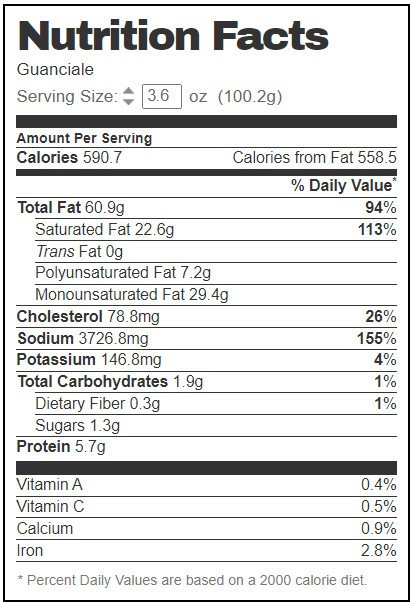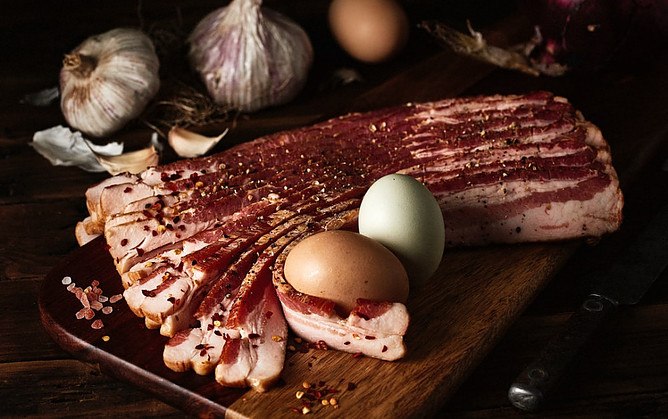Searching if Guanciale is suitable for people with diabetes, right? Do you want to know the alternative options too? Here we’ve explained everything you need to know about Guanciale and Diabetes to answer the most important question – Is Guanciale Good For Diabetics?
What is Guanciale?
In Italy, Guanciale or “guancia” is a popular form of cured meat.
Guanciale comes from the Italian word “guanciale,” which means pillow.
Guanciale originates from the term guanciale, which means cheek. It is cut from the jowl of the pig. The cheek is one of the fattiest parts of the pig, and thus Guanciale has a rich level of flavour.
It’s a specialty of South Italy, particularly in the Campania region, i.e., the place most known for its pork dishes.
This meat has diffused to other parts of Italy and Europe, though it’s still most popular in Campania, so people sometimes say that Guanciale comes from southern Italy.
Nowadays, it is usually used as an ingredient in pasta or pizza dishes or served thinly sliced or diced on top of the bread as bruschetta.
Like Pancetta, you should simmer Guanciale over low heat for at least 3 hours until golden-brown and crisp. Order now to taste how amazing these slices are with your favourite pasta or pizza!
Let’s turn on to the content of Guanciale before discussing its effect on diabetes.
Nutritional Content of Guanciale

Guanciale and Diabetes
If you’re with diabetes, remember that the first step to reducing your diabetes is to eat a healthy diet.
Choose natural proteins and fats over high-carb foods and sugars to help curb your cravings and provide your body with its nutrients. Guanciale is a good choice for this kind of diabetic diet.
Guanciale is made from pork cheeks and has almost no carbohydrates since there is not much meat on the pig’s cheeks.
Having pork as its primary ingredient, Guanciale can be used in Pancetta or bacon in recipes. However, you must keep an eye on its sodium content. It must be eaten in small quantities combined with fruits and vegetables
to eradicate sodium’s effect on your diabetes.
Guanciale vs Pancetta – What is The Difference?
Pancetta is probably one of the most commonly used pieces of pork in Italian cuisine, and it’s become quite popular in the United States as well.
If you’ve heard of Pancetta but have never tried it before, you’ve probably asked yourself: what is the difference between Pancetta and Guanciale?
I’d like to delve into the differences between Pancetta and Guanciale now…
Guanciale is an Italian cured meat, similar to bacon, made from pork cheeks. It has a distinctive flavour because of the significant fat and the rich collagen.
Due to its semi-solid state, it needs to be cut with a diabetes-friendly knife and not sliced on a machine.
It is frequently used in pasta dishes including Spaghetti Alla Carbonara and bucatini all amatriciana and other words like “pizza alla giudia.”
In contrast, Pancetta is Italian cured bacon made from pork belly.
There are two types: pancetta arrotolata rolled into a cylinder, and pancetta stesa (flat Pancetta), which is not moved.
As with Guanciale, the skin is usually left on, and the fat content varies.
Pancetta comes salted or unsalted, aged for 18 months, and maybe smoked or unsmoked. (Be aware of effects of Smoked Salt)
Pancetta has a broader flavour than Guanciale. It’s smokier and usually stronger in saltiness.
Pancetta cannot be consumed raw, whereas Guanciale is perfect for sautéing or frying. If a recipe calls for many steps, it is for Pancetta, but if you want to go for more flavour, opt for Guanciale.
Guanciale vs Bacon – What is The Difference?
Bacon is a cut of pork made from either the belly or the back of the pig that has been cured but not smoked. That same piece of meat can be smoked to make “smoked bacon” or “country bacon.”
The smoking process adds flavour, but the curing gives bacon its characteristic saltiness and makes it safe to eat without cooking.
Slab bacon is a piece taken from the side of the pig, made up of three types of meat: the belly (streaky, also called fatty or Iowa bacon), the loin (Canadian bacon), and fatback (usually unsmoked).
Regular sliced bacon is cut from the slab of bacon. Thinly sliced bacon is usually wave cut, less than ¼ inch thick (1/8 inch is typical), typically used on burgers, pizza and sandwiches, and maybe fried to crispness.
Thick sliced bacon is usually wave cut, sometimes over 1/4 inch thick and may be sold as thick-cut, applewood smoked, or hickory-smoked. It has more meat than regular sliced bacon because of the ¼ inch thickness.
Ends and pieces are small pieces trimmed from full slabs of bacon by slicing parallel to the ends or ends from pieces leftover from cutting full slabs.
They are sold at reduced prices for home use; they are frequently chopped and sold in bulk in hearty soups containing potatoes or cassava root or simmered with lentils for meals for the poor.
End cuts cannot be sold whole as they are too irregularly shaped for packaging in rectangular cartons.
The most significant difference between Guanciale and bacon is that the former comes from a pig’s cheek while the latter comes from pork belly.
In addition to this, bacon is cured in a brine solution and then smoked, whereas Guanciale is only cured.
Guanciale, however, has a more intense flavour than bacon.
Is Guanciale Good For Diabetics?
Guanciale is a type of cured meat made from pork jowls or cheeks. It is not unhealthy, but it contains a high amount of sodium, which can cause problems for people with kidney diseases, chronic heart problems, and diabetes.
Guanciale basically falls between bacon and Pancetta in terms of healthiness. While it does have a lower amount of sodium, it still contains more than you should consume in a meal for heart health, and given its rarity, it’s going to be hard to find ways to use it all the time.
Ultimately, whether Guanciale is good or bad for diabetics will probably depend on the individual.
It may be a little too fatty for some who struggle with their weight to be on the safe side. But it might just be the salt substitute they were looking for, others who are already watching their sodium intake.
Plus, if you’re not at risk of developing heart disease or high blood pressure, enjoy it.
Guanciale is one of those foods that are best in moderation (at least, that’s what we think), and since overeating fat isn’t great for anyone, especially diabetics – it’s probably best to keep things moderate.
Is Guanciale Really Bad For Diabetics?
Guanciale and most other fat cuts indeed have more than one hundred per cent (100%) of the amount of fat the USDA recommends to consume in a single meal. It’s also true that most meats contain saturated fats that increase harmful cholesterol levels and decrease good cholesterol levels in the body, leading to heart disease.
But, is this enough evidence to suggest that Guanciale is not suitable for diabetics?
Overall, Guanciale was found to be more dangerous than regular bacon. But other studies have found that it’s less hazardous than factory-made bacon, so the jury is still out.
Regardless, it doesn’t mean you should go hog-wild with Guanciale if you have diabetes – moderation is probably the best bet for everyone.
Guanciale made with pork cheek will have about the same impact on your blood sugar levels as bacon or prosciutto. Guanciale made with pig jowl, however, is a different story!
Pork jowl is high in fats and will raise your blood sugar by quite a lot. Since diabetes is a severe medical condition that can lead to serious health complications, it’s best if diabetics follow a doctor’s advice closely.
In the end, Guanciale is considered in moderation to be a potentially healthy addition to a diabetic diet. This is provided that one consumes it alongside fresh foods like vegetables and fruit.
Processed foods with added sugars or empty carbs and fats are something to generally avoid.
You also should keep a keen eye on the sodium percentage.
If you’re a diabetic with solid immunity and the diabetes isn’t that severe, then consuming a strict amount of Guanciale may be okay. You should still inform your doctor about your consumption though.
Health Tips For Eating If You Love Guanciale
Like you, we’re always glad to uncover new information and clarifications…
A recent study from Italy has suggested that people with type 2 diabetes should limit or avoid high-fat cuts of meat, such as regular ground beef, bologna, hot dogs, sausage, bacon, and Guanciale. Given the similar effects of these meats on blood glucose levels, it’s also important to note that many other factors played a role in this study.
We think the most important takeaway is this: if you like Guanciale and have diabetes, don’t panic. Just pay attention to portion sizes and strive to eat a balanced diet.
At the end of the day, there are some significant differences between Guanciale and bacon. We’ve already analyzed the nutritional value of Guanciale compared to other cured meats like bacon and prosciutto.
And, while we don’t want to give you the impression that Guanciale is a better choice, it certainly isn’t the worst either.
In fact, it has some health benefits that may make it a suitable fit for some people with diabetes who do not have too many restrictions on their diet.
Alternatives To Guanciale For Diabetics
Bacon and Pancetta are good alternatives for Guanciale, but they both contain a high sodium percentage per serving. Thus, that makes them the wrong choice.
Pancetta can be a good alternative if consumed in smaller quantities with fruits and vegetables. There are many ways you can healthily cook pork for a diabetic.
- Italian Pancetta
Italian Pancetta is a type of salumi that hails from central Italy, where it is traditionally made from pork belly and encased in natural hog casings.
Italian Pancetta has a firm texture that makes it well suited for frying, but it can also be eaten smoked, air dried, or raw (as part of carpaccio).
You can use this excellent cured meat to add body and flavour to dishes like omelettes and soups, or try cubing it into small pieces and using it as the base of pasta sauces.
- Speck
Speck is another alternative for Guanciale.
Speck is a cured pork product made by salting and smoking pork belly.
Compared to prosciutto and Guanciale, it has a much more intense flavour thanks to the curing process. It makes a lump of excellent breakfast meat served with honey or maple syrup and eggs.
Speck has a more intense flavor than prosciutto di parma, but with less fattiness than guanciale.
To serve, cut off slices of speck to eat alongside antipasto or an appetizer.
You can also cook it into diced dishes with other ingredients or put it on pizza.
- Prosciutto
Both prosciutto and Guanciale are flavorful and delicious when served. However, prosciutto is leaner than Guanciale.
For people with diabetes, fatty meat can cause spikes in blood glucose levels, mainly if consumed in large quantities. This should make prosciutto a go-to option if you have diabetes and want to enjoy some cured meat at home or on the go.
- Pork Jowl
For many people with diabetes, low-carb diets are recommended to improve their health. The ketogenic diet is one example of one such diet, which has shown positive results in reducing the symptoms of diabetes.
Many alternatives exist for those who may have a difficult time giving up traditional foods, including meats. Pork jowl can be a great alternative to Guanciale for diabetics and is readily available in many grocery stores today.
Conclusion
Our main takeaway from this article is that eating smaller servings of foods can go a long way towards helping to improve your ability to manage your blood pressure.
In other words, reducing the overall quantity of food you eat will help control salt intake, and finding healthy alternatives for high-sodium foods is a great way to balance things out.
And, if you’re wondering why all of these matters in the first place, one answer is simple: an unhealthy diet can result in medical issues like hypertension, so it’s essential to maintain an awareness of what you’re putting into your body.
Guanciale is a lump of delicious meat to be included in a diabetic diet. But before everything else, it must be well-monitored, especially when it comes to salt content.
Guanciale can be used in place of Pancetta or bacon in certain dishes. Overall, Guanciale is a slice of low-fat meat with little sugar content and makes a decent add-on for those on a healthy diet regime.















